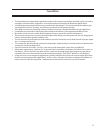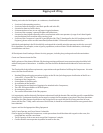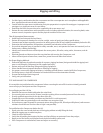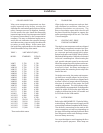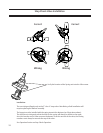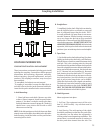
18
This information is taken from ASHRAE 15-89 and
ANSI B31.5. The installing contractor should be
thoroughly familiar with these codes, as well as
any local codes.
V. ELECTRICAL CONNECTIONS
The single screw compressor units are shipped
with all package mounted controls wired. The
standard control power is 115 volts 60 Hertz,
single phase. If a 115 volt supply is not available, a
control transformer may be required. The power
source must be connected to the control panel
according to the electrical diagrams.
The units are shipped without the compressor
motor starter. Field wiring is required between
the eld mounted starters and package mounted
motors.
Additional control wiring in the eld is also re-
quired. Dry contacts are provided in the control
panel for starting the screw compressor motor.
These contacts are to be wired in series with the
starter coils. A current transformer is supplied
along with the compressor unit, and is located
in the motor junction box. This transformer is to
be installed around one phase of the compres-
sor motor starter. A normally open auxiliary
contact from the compressor motor starter is
also required.
Terminal locations for this wiring can be found
on the wiring diagram supplied with this unit.
Additional aspects of the electrical operation of
the single screw units are covered in the start up
and operation section of this manual.
VI. TESTING REFRIGERATION
SYSTEM FOR LEAKS
Vilter equipment is tested for leaks at the fac-
tory. One the most important steps in putting a
refrigeration system into operation is eld test-
ing for leaks. This must be done to assure a tight
system that will operate without any appreciable
loss of refrigerant. To test for leaks, the system
pressure must be built up. Test pressures for
various refrigerants are listed in ANSI B9.1-1971
code brochure entitle “Safety Code for Mechani-
cal Refrigeration”. These pressures will usually
sufce, however, it is advisable to check local
codes as they may differ. Before testing may
proceed, several things must be done.
First, if test pressures exceed the settings of
the system, relief valves or safety devices, they
must be removed and the connection plugged
during the test. Secondly, all valves should be
opened except those leading to the atmosphere.
Then, open all solenoids and pressure regula-
tors by the manual lifting stems. All bypass
arrangements must also be opened. Because
of differences in characteristics of the various
refrigerants, two different testing methods are
necessary.
A. Ammonia Systems
Dry nitrogen may be used to raise the pressure
in an ammonia system to the proper level for
the test. The gas may be put into the system
through the charging valve or any other suitable
opening. Adjust the pressure regulator on the
bottle to prevent over-pressurization. Do not
exceed the pressure rating on the vessel with
the lowest pressure rating.
Carbon Dioxide should NOT be used as a test-
ing gas in a system where ammonia is already
dissolved in any moisture remaining. This will
cause ammonium carbonate to precipitate
when the CO
2
is added. If heavy enough, this
precipitate may cause the machine to freeze
and clog the strainer.
A mixture of four parts water to one part liquid
soap, with a few drops of glycerin added, makes
a good solution. Apply this mixture with a one
inch round brush at all anges, threaded joints,
and welds. Repair all visible leaks. If possible,
leave the pressure on over night. A small pres-
sure drop of 5 lbs. Over this period indicates a
very tight system.
Remember to note the ambient temperature,
as a change in temperature will cause a change
in pressure.
After the system is thoroughly tested, open
all valves on the lowest part of the system so
the gas will oat away from the compressor.
Installation




